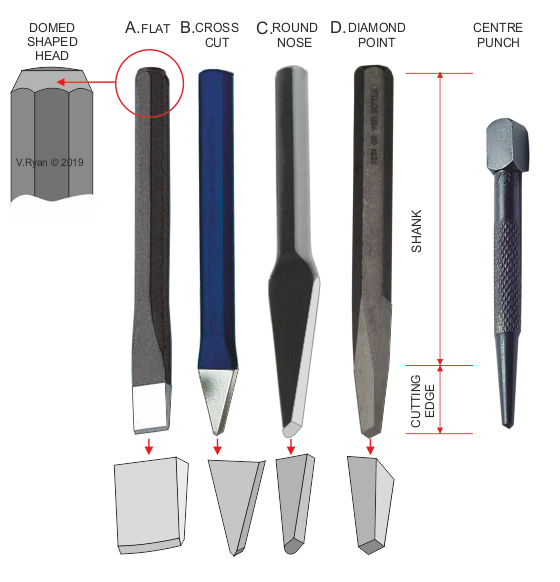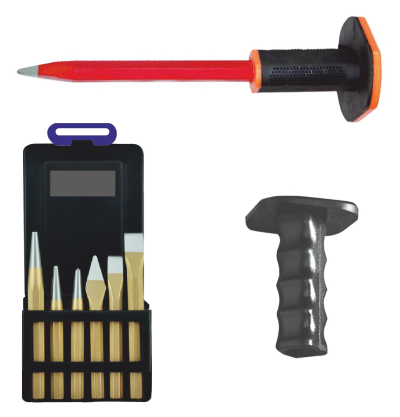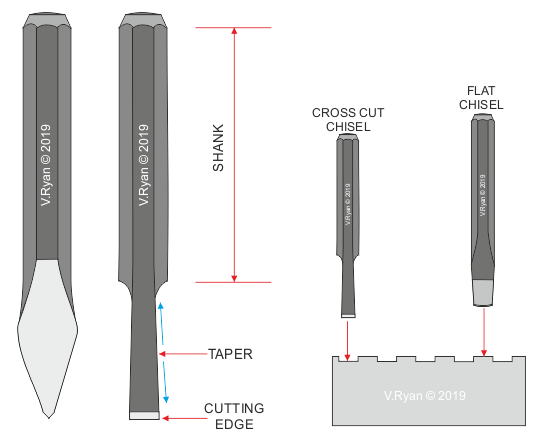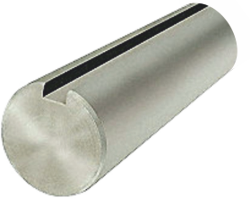| CLICK HERE FOR INDEX PAGE |
| |
| COLD CHISELS |
| V.Ryan © 2019 |
| |
| PDF FILE - CLICK HERE FOR PRINTABLE WORKSHEET |
| |
Cold chisels are used to cut and shape ‘cold’ metal, although they are only ocassionally used in a modern workshop. They are manufactured (forged) from octagonal section, cast tool steel and are a manual cutting tool used by engineers. The highest quality cold chisels are manufactured from nickel chromium steel. The cutting edge is ground and then hardened and tempered, to lengthen the life of the sharp edge. The shank is left ‘soft’, as it must be able to withstand the shock of heavy blows from a ball pein hammer.
It is not uncommon for a quality worn cold chisel, to be re-forged to shape, ground and the edge hardened and tempered.
They are supplied in a range of sizes but there are four main types (seen below): |
|
| Flat Cold Chisel, Cross Cut Chisel, Round Nose Chisel and Diamond Point Chisel. |
| |
| Most cold chisels have a ‘dome shaped’ head. When a cold chisel is continually hit by a ball pein hammer, it eventually creates burrs. These can be sharp and can spread out, making it more likely that the hammer will slip off the head, putting the hand of the user at risk. When burring occurs, the head should be ground to the correct shape. |
| |
|
|
| |
 |
| |
|
|
| |
| It is quite common for a cold chisel to have a rubber holder, which makes using the cold chisel more comfortable and safer. Concentration is required when using a cold chisel, as inaccurate use of the hammer, can result in ‘painful’ accidents, with hands / fingers being hit. The rubber holder makes it easier to hold the chisel and if a slip with the hammer occurs, hands and fingers are protected. However, some engineers say that the rubber holder leads to less accurate chisel work, as it ‘muffles’ the sense of ‘feel’, in the hands. |
| |
| Spare protective grips can be bought separately, although it is important to check that they will fit existing cold chisels. |
| |
 |
| |
| It is worth noting that centre punches are often regarded as a type of cold chisel. Therefore, cold chisels are often purchased as part of a set of chisels and punches, as seen opposite. |
| |
| THE CROSS CUT CHISEL |
| |
| The Cross Cut Chisel tapers slightly, from the cutting edge to the shank, making it ideal for cutting slots, grooves and keyways. Much of this work is now carried out on milling machines. |
| |
| Traditionally, the cross cut chisel was used to cut grooves into the surface of a thick metal plate, as the first stage of removing material across its entire surface. After cutting the groves, the remaining material would be removed with a flat chisel. |
| |
 |
| |
|
|
| |
 |
|
The keyway on this shaft would have once been prepared by a skilled engineer, using a cross cut cold chisel. |
| |
| |
| CLICK HERE FOR EQUIPMENT AND PROCESSES INDEX PAGE |
| |
|
| |
|



